List of Authors
>>About this blog
Recent blog post
|
[Asunaro]
December 30, 2017 16:00
When you go to souvenir shops, various beckoning cats
You can see it.
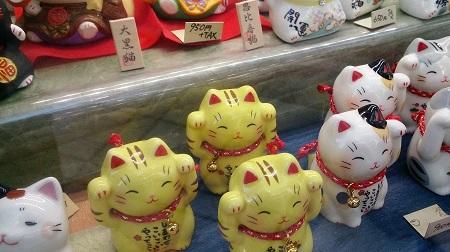
If you look closely, you can see the rising hand (front leg?) But
It's the right hand or the left hand.
It seems to have a meaning.
The right hand invites money.
The left hand invites people.
In both hands, both money luck and a thousand customers who invite people
It is said that there is a great deal.
And the higher the hand you raise, the more you invite the distant fortune.
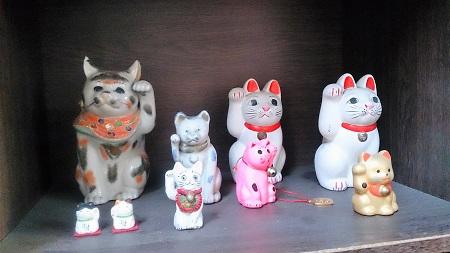
Nihonbashi has been famous as a "Prayer for lost cats" since the Edo period.
There are many beckoning cats at the shrine as a thank you for fulfilling your wish.
I have it.
Beckoning cats have been loved by many Japanese since ancient times.
I hear that it is becoming more popular overseas.
You are still alive even in the year of the dog.
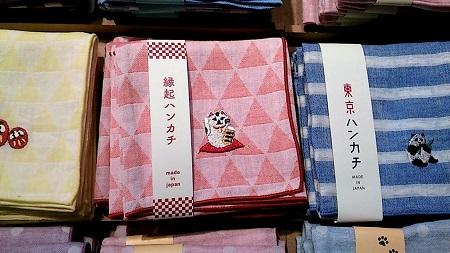
◆Sanko Inari Shrine
2-1-13, Nihonbashihoridomecho, Chuo-ku, Tokyo
[Silver]
December 29, 2017 18:00
In a corner of Kakigaracho Park, there is a large foot-shaped sculpture.
The author is Masayuki Nagare, a world-famous sculptor.
The name of the work is "Edo Komata", and the production year is 1992.
It's been about 10 years since I learned about the existence of this sculpture. However, it did not match the year of the adjacent TCAT (Tokyo Shitai Air Terminal, opened on July 1, 1972 (Showa 47) and the Royal Park Hotel (June 1, 1989, adjacent to Tokyo City Air Terminal (T-CAT) in Chuo-ku, Tokyo), so it   remained with questions. remained with questions.
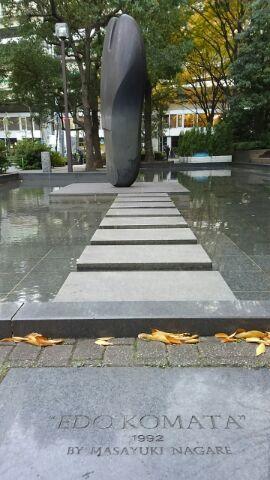
Did these travel and tourism industries set up in hope of "travel safety"? I kept thinking about it. It's been about five years since my friend WLY told me to write a blog post.
This time,  at last, I was able to know how this sculpture was installed on the Internet. at last, I was able to know how this sculpture was installed on the Internet. 
According to the report, Chuo-ku said, "To commemorate the Declaration of Peace City, it was installed as a symbol of the city's peace at Kakigaracho Park adjacent to the Tokyo City Air Terminal, which is equivalent to the empty entrance of Chuo-ku." is.
The URL of the announcement is posted on the "Heiwa, Chuo-ku Prayer Virtual Museum" and is here.
http://www.city.chuo.lg.jp/heiwa/monument/edokomata/index.html
My long doubts were clear and clear . Have a safe trip! Bom voyage! . Have a safe trip! Bom voyage!
[The Monkey]
December 27, 2017 12:00
At the base of Nihonbashi, there is a brewed restaurant <Nihonbashimurocho Honen Manfuku> along the river. "Kawaterasu" is also set up, which transmits cultural information not only through eating and drinking, but also through product sales and lectures. I participated in Honen Manpuku Juku, which is held every month here. The lecturer this time was Yasubee Hosoda, a long-established Japanese confectionery company <Eitaro Sohonpo>, and a person like a living character of the 92-year-old Nihonbashi neighborhood.
There are four theories about why it was named Nihonbashi.
1.Overlooking Mt. Tsukuba to the east and Mount Fuji to the west, you can see the sunrise rising on the sea, and the best view in Japan.
2.Because it is a bridge in the center of Edo and is the starting point of highways to the whole country.
3.When Ieyasu Tokugawa built a town in Edo, it was a bridge made by daimyo across the country providing people, money and goods.
4.According to the theory of Yasaburo Ikeda of Keio University, during the Edo period, when the Nihonbashi River was called Hirakawa, Hitotsubashi, Takebashi, Itabashi, etc. were called Nihonbashi, but it was suddenly called Nihonbashi.
The nameplate of the bridge pillar was written by Yoshinobu Tokugawa, the 15th general, which is easy to read and beautiful typeface. Nihonbashi, the name of this bridge, the horizontal line (1) in the middle of the character of the book is a dot (,), and Kobo also said that it was an error in the brush or trivia.
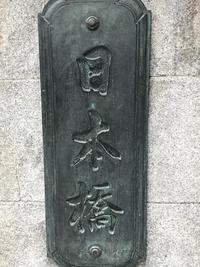 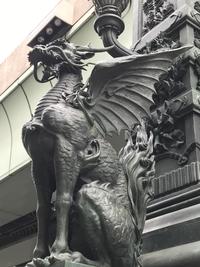
In addition, a trivia statue of Kirin on the bridge, a movie called "Kirin's Wings". In fact, this is not a wing, but a fin of Kirin. The wings originally evolved from the bird's forefoot, and it is true that this Kirin has a solid forefo ot on the fish shore until the Great Kanto Earthquake, and it is not a `` jump from here to the world '' It's put in the thought. ot on the fish shore until the Great Kanto Earthquake, and it is not a `` jump from here to the world '' It's put in the thought.
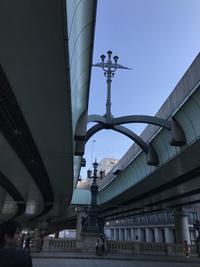 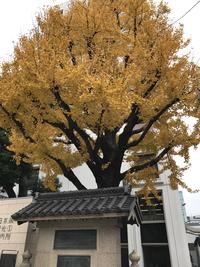
When a wooden bridge was replaced with a stone arch bridge in 1911, a beautiful bridge was built for the 1964 Tokyo Olympics, where one-tenth of the total construction cost was spent on decorative art. Covered directly above. Since then, Mr. Hosoda and other locals have been exercising to regain the landscape and eliminate the anxiety of earthquake resistance for 50 years, and the signatures have been collected 490,000!
This year, with the aging of the capital city, the underground construction of expressways has begun to be considered with the aim of reviving the landscape of Nihonbashi and redeveloping the area around Nihonbashi. Will there be a day when this scenery will change in the near future?
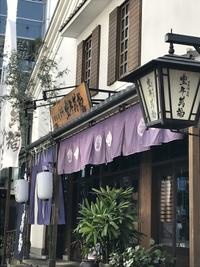
For inquiries about Honen Manpuku Juku, please contact the monthly Nihonbashi Editorial Department.
03-6202-1221 (weekdays from 10:00 to 18:00)
Next time, Saturday, January 20 14: 00-16: 00
The world is transmitted from Nihonbashi [France Edition].
[Dimini ☆ Cricket]
December 26, 2017 09:00
Seven years after becoming a correspondent of the Chuo-ku Tourism Association, I received the Chuo-ku Tourism Certification three times, and even if I intend to know about the historical monuments of Chuo-ku, I realize that there are things that I overlook.
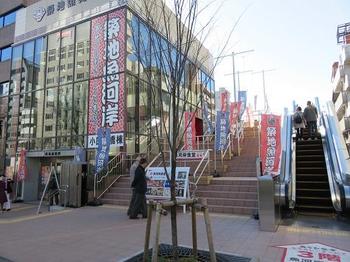
At Tsukiji 6-chome, along Harumi-dori St., which is crowded with shoppers at the end of the year, there was a monument to Hachikoichiu.
The Odawara Bridge Building on the Tsukiji Fish Bank can be said to be a side place facing Harumi-dori St. (map below , red) , red)
I must have passed in front of you many times...
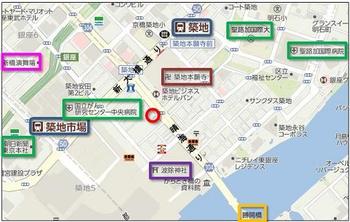
In the first place, it seems that Hakkoichi is to make the world and the whole world a single house, and "Chronicles of Japan" covers the entire world. It seems that he interpreted the whole world as a single house.
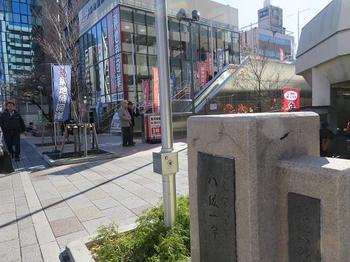
It was pointed out that this was used as a slogan to justify Japan's invasion of China and Southeast Asia during World War II, and it was a word that I rarely hear in postwar Japan.
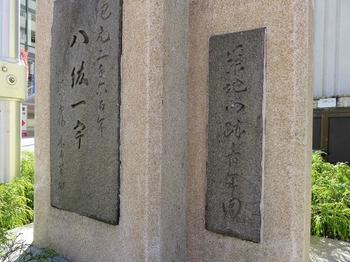
This area around Tsukiji is also the "birthplace of the Navy" and an area closely related to the "Great Japanese Empire Navy" so that you can visit the naval historic sites, and this monument may have been set up here in connection.
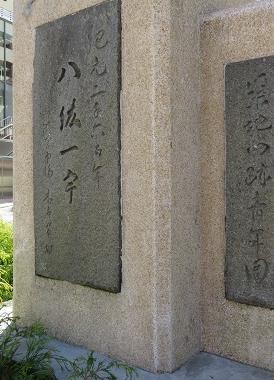
By the way, Chuo-ku sightseeing certification was finally one month later (Saturday, January 27, 2018)
This monument is not listed in the official text "Chuo-ku Monoshiri Encyclopedia", so it is unlikely that you will enter the Chuo-ku Tourism Test at the end of next month (it should be)
     
[Dimini ☆ Cricket]
December 22, 2017 09:00
It's an illusion to talk about landscapes that I often saw during the Showa era, when the Heisei era is about to end, but I feel like "social pots" have recently disappeared.
The "Social Hot Pot" is a street fundraising campaign conducted by the Salvation Army at the end of the year to support the poor in life, etc. It is an iron pot.
It is also the seasonal word of Haiku (winter) as a feature that colors the city at the end of the year every year.
It is a "social pot" that has become rarely seen, but there is a monument in Chuo-ku, the monument of the salvation army, which is the parent of the activity. 
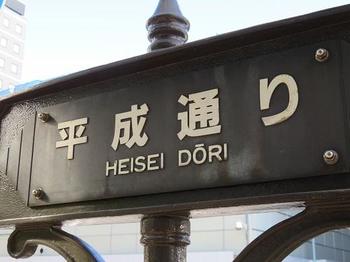
It is right next  to the intersection on the north side across Tsukijibashi along Heisei Dori. to the intersection on the north side across Tsukijibashi along Heisei Dori.
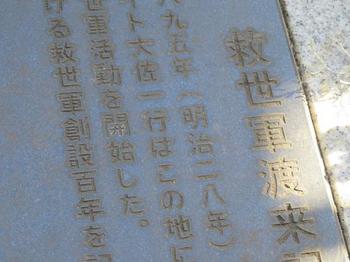
For more information about the origin of this monument, please refer  to the blog post published last June. to the blog post published last June.
It is said that Colonel Wright, who came to Japan, set up the headquarters in this area, and it was set up in 1995 to commemorate the 100th anniversary of the arrival.
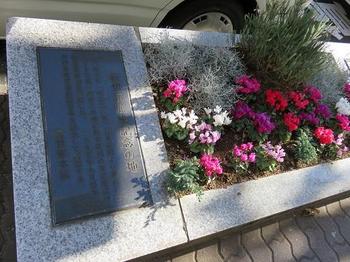
The fact that my eyes went to this monument may be conscious of the New Year's Day.
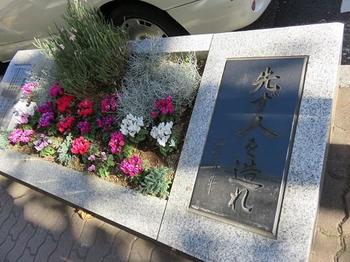
Click here for a blog that introduced this monument last June. ⇒
/archive/2016/06/post-3429.html
     
1.
December 20, 2017 12:00
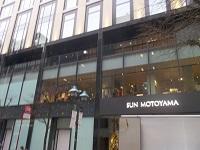 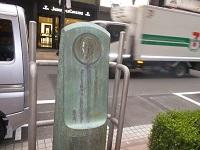
The Asahi Building on Namiki-dori St., which was being rebuilt, was completed, and Rolex and Louis Vuitton opened sequentially from November 15th, and San Motoyama returned to make it even more fashionable. We are looking forward to opening the Hyatt Hotel Chain Hyatt St Rick Ginza on January 22 next year from the 3rd to the 12th floor. I hear it's 164 rooms. The song monument of Takuboku Ishikawa, which I was worried about, was also in the original place. Something safe. As you know, the location of this Asahi Building is the place where the Asahi Shimbun entered Osaka and set up the company building in 1888 (1888). The first place is Motosukiyacho 2-chome, a little far away, but two months later, it moved to Takiyamamachi (current location) and moved to Yurakucho (current location of Marion) in 1927 (1927). I was publishing a newspaper here. It is also famous for having a selling-selling writer join the company and writing it. In 1904, Futabatei Shitaku, and in 1907, Soseki Natsume joined the company. Soseki, the 150th anniversary of this year's birth, was a lecturer at Tokyo Imperial University before joining Asahi. "I quit teaching at Teidai and joined a newspaper company" seems to have caused a great sensation at that time. Tokyo Imperial University lecturer's salary is 800 yen per year, while Asahi's monthly salary is 200 yen, so it was about tripled, so it was like Soseki's 40-year-old brilliant traveryu. The first novel that I moved to Asahi and published is "Gobijingusa". The critic, Toyotaka Komiya, wrote the following: "The fact that Soseki quit college and joined a newspaper company was a major sensation at that time. It is said that Soseki will finally write "Ago Bijingus" this time, so Mitsukoshi will sell "Ago Bijingus yukata". Gyokudo sells "gobijin grass rings". The newspaper salesman at the station said, "Asahi Shimbun" and called "Asahi Shimbun" and made a big fuss in the world. "
Two years after Soseki, Takuboku Ishikawa joined the company as a proofreader in 1909 (1909). The monthly salary was 25 yen, and the following year he was recognized for his talent and became the winner of the Asahi Kadan. Prices in the Meiji 40s are about 20,000 times in modern times ("Meiji Gold Account" Hirofumi Yamamoto), so Soseki's annual salary is about 48 million yen and Takuboku's about 6 million yen. By the way, Futabatei Shikuro is half that of Soseki. When you look at the new building, be sure to take a look at Takuboku's poetry monument on the road side.
Takuboku Ishikawa Song Monument "The Isogashi Fish of the Time of the Light of the Newspaper Light in Takiyamamachi, Kyobashi"
Ginza 6-6-7 (Namiki-dori St.)
|
Links
|
![]()


![]()

















